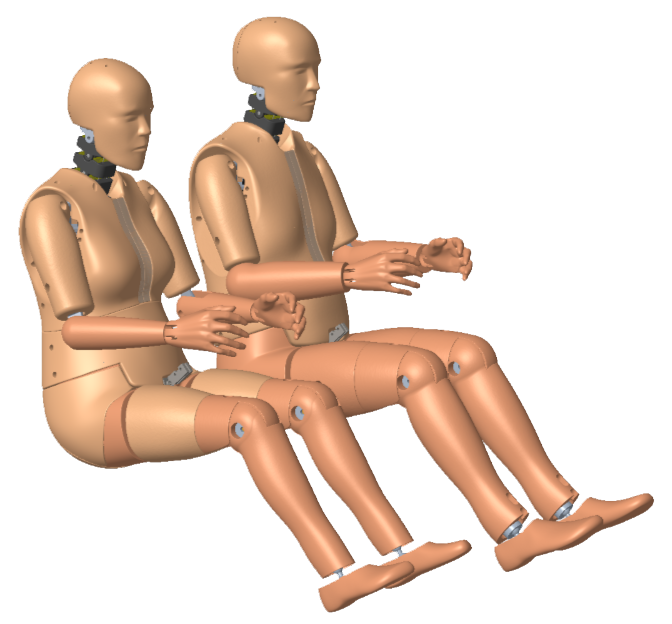
Gender Bias in Auto Safety
The Long Road to Equality
Despite advancements in technology, women are significantly more likely to suffer severe injuries and fatalities in car crashes—not because they are worse drivers, (women account for fewer auto crashes than men in America) but because the safety features in vehicles do not account well enough for their anatomy. Until recent crash test dummy innovations by Swedish engineer, researcher and professor Astrid Linder, automobile crash tests were primarily built and designed for the average male body. Additionally, women, in larger numbers than men, encounter safety risks in parking garages and walking to and from transit stops, as well as harassment while using public transportation. These factors combined highlight the need to advance safety for women in safety tests and in public spaces.
Women in general have greater lower body muscle mass than men, while men have greater upper body muscle mass, especially in the neck, torso and shoulders, making them twice as resistant to impact forces, such as spinal injuries and whiplash (Brumbelow, 2021). Women’s lighter heads, different neck position, smaller necks and lower muscle mass in the upper body, results in greater head acceleration during crashes (Linder & Svedberg, 2019). Since whiplash protections, such as headrests, are designed for male neck strength and head positioning, women’s heads can snap back more violently even when these safety features are in place, as they don’t account well enough for women’s anatomy (Forman et al., 2019).
Additional research from Stanford University shows that women tend to have shorter torsos, the presence of breast tissues, as well as different spinal curvatures which makes both seatbelts and airbags less effective for women’s bodies, than men’s (Stanford University, n.d.). Airbags are also optimized for a man’s average chest, which can increase the risk of injury for women drivers and passengers. Pregnant women face even greater dangers, since seatbelts are not tested for the impact on the fetus if a crash does occur.
Swedish development
Professor Astrid Linder, a world leading road safety researcher from Sweden, has spent 20 years creating the world’s first accurate female dummy. The female (SET50F) and male dummy (SET50M) created by Linder were introduced to the world in the summer of 2023, but had previously been represented at an international road safety conference. “SET stands for Seat Evaluation Tool, and 50 is the median value for the height and weight of real men and women.” Read more about this here.

Female and male crash dummy comparison
Illustration of the SET 50F and 50M from the publication Karemyr et al. 2022

Astrid Linder with SET50F
Photo credit: Hejdlösa bilder / VTI
Despite the female dummy being introduced almost two years ago, it is still not widely used, as car manufacturers in both the US and EU prioritize male dummies in crash testing, leaving car manufacturers with little to no incentive to improve safety measures for women (Elesser, 2024). There is no requirement to use female dummies for driver’s seat tests, meaning most safety assessments fail to account for how crashes actually affect women’s bodies (Mueller, 2019). This goes against the legal requirements of the European Union under Article 8 of the Treaty of Functioning of the European Union – “ In all its activities, the Union shall aim to eliminate inequalities, and to promote equality, between men and women.”. Additionally, pregnant women are still completely overlooked in safety testing, despite the significant risks that seatbelts and airbags can pose to the fetus (and mother) in a crash (Volvo Cars, 2003). With female crash dummies having been researched for more than 20 years and being available for almost two years, safety regulations must change in order to improve auto crash safety for women.
- Female crash test dummies need to be required and mandated in all seating positions to assure more accurate safety assessment of cars being tested.
- Seatbelts and airbags also need to be improved to be able to account for different body anatomies, including those of pregnant women.
- Safety ratings of cars need to be able to accurately describe female crash data, which currently is impossible only knowing the data and results of men’s bodies in crashes.
Finally, more research is needed on gender-specific injuries, particularly in areas such as head, neck, and chest trauma, to develop safety features that better protect all drivers and passengers, despite length, weight and gender.

Astrid Linder with SET50F
Imaged used as feature
Photo credit: Hejdlösa bilder / VTI

References
Brumbelow, M. L. (2021). Injury risks and crashworthiness benefits for females and males: Which differences are physiological? Insurance Institute for Highway Safety. Retrieved from https://www.iihs.org/topics/bibliography/ref/2219
Linder, A., & Svedberg, W. (2019). Review of average sized male and female occupant models in European regulatory safety assessment tests and European laws: Gaps and bridging suggestions. Accident Analysis & Prevention, 127, 156–162. https://doi.org/10.1016/j.aap.2019.02.030
Forman, J., Poplin, G. S., Shaw, C. G., McMurry, T. L., Schmidt, K., Ash, J., & Sunnevang, C. (2019). Automobile injury trends in the contemporary fleet: Belted occupants in frontal collisions. Traffic Injury Prevention, 20(6), 607–612. https://doi.org/10.1080/15389588.2019.1621595
Stanford University. (n.d.). Inclusive crash test dummies: Analyzing reference models. Gendered Innovations. Retrieved from https://genderedinnovations.stanford.edu/case-studies/crash.html
Elesser, K. (2024, February 20). Will female crash dummies improve safety for women? It’s complicated. Forbes. Retrieved from https://www.forbes.com/sites/kimelsesser/2024/02/20/will-female-crash-dummies-improve-road-safety-for-women-the-answer-is-complicated/
Mueller, B. (2019, October 28). Dummies used in motor vehicle crash tests favor men and put women at risk, new report says. Forbes. Retrieved from https://www.forbes.com/sites/tanyamohn/2019/10/28/dummies-used-in-motor-vehicle-crash-tests-favor-men-and-put-women-at-risk-new-report-says/
Volvo Cars. (2003, June 20). Volvo Cars develops world’s first pregnant crash test dummy. Volvo Car USA Newsroom. Retrieved from https://www.media.volvocars.com/us/en-us/media/pressreleases/958

Want to work with us? Feeling inspired?
Contact us at info@dcrdesign.net or checkout our social medias: LinkedIn and Instagram
For other related safety issues regarding gender bias, we have added some resources:
Parking lot safety, Podcast on subject,




